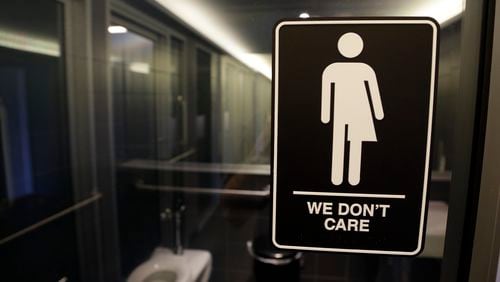Why are community protests erupting over transgender bathrooms in schools? The safety threats being alleged are hypothetical with no basis in reality.
The only complaint I’ve ever directly heard about gender issues and school lavatories in Georgia came from a grandfather unhappy with a co-ed restroom in his grandchild’s pre-school classroom. That single complaint in 1996 led to a bill in the General Assembly outlawing unisex bathrooms for preschoolers. In the brief debate, House members discussed whether it's a sin for a 3-year-old to see another in the bathroom.
By the way, the debate and the bill itself garnered exactly one line in the AJC 10 years ago. In today’s climate, it would explode into a national story.
Last night community members packed a school board meeting in Fannin County to protest what they saw as the danger of transgender students in school restrooms. Speakers argued it was a safety issue.
If Fannin wanted to deal with actual safety threats to children, it – and every other Georgia county – would focus on kids texting while driving and the use of drugs and alcohol. That's what's endangering children.
Who writes the scripts for these imaginary crises and how does everyone know their part? Are there three guys in a basement plotting what fake controversy will rile up people and then using social media to hype it? If so, I wish this committee for chaos could energize folks around math performance, literacy and graduation rates. If community members are going to march on schools boards as they did last night in Blue Ridge, let it be about something that matters.
That said, the federal government is now addressing the issue, maintaining in a “guidance” released today that schools, under Title IX, must ensure transgender students can use bathrooms and locker rooms that match their chosen gender identity.
The federal action comes in response to a North Carolina law enacted in March prohibiting Charlotte and other cities from passing any ordinances protecting the rights of LGBT people. Earlier this week, the Justice Department warned North Carolina that it could lose millions federal funding by discriminating against transgender people in bathroom access.
The federal stance is drawing fire.
Jeremy Tedesco, senior counsel for the nonprofit legal foundation Alliance Defending Freedom, said, "The administration's new guidelines simply reinforce what has been abundantly clear already—that it has a political goal of forcing women to share restrooms and locker rooms with men across the nation and will spread falsehoods about federal law to achieve its aims. This is precisely why we have filed two federal lawsuits, one in Illinois and one in North Carolina, on behalf of parents and students who are understandably concerned about their children. Solutions exist to accommodate everyone without violating anyone's privacy rights, but the administration won't entertain those solutions because of its preference to unlawfully impose its political will through threats and intimidation."
Here is the joint U.S. Departments of Education and Justice statement released today:
The U.S. Departments of Education and Justice released joint guidance today to help provide educators the information they need to ensure that all students, including transgender students, can attend school in an environment free from discrimination based on sex.
Recently, questions have arisen from school districts, colleges and universities, and others about transgender students and how to best ensure these students, and non-transgender students, can all enjoy a safe and discrimination-free environment.
Under Title IX of the Education Amendments of 1972, schools receiving federal money may not discriminate based on a student's sex, including a student's transgender status. The guidance makes clear that both federal agencies treat a student's gender identity as the student's sex for purposes of enforcing Title IX.
“No student should ever have to go through the experience of feeling unwelcome at school or on a college campus,” said U.S. Secretary of Education John B. King Jr. “This guidance further clarifies what we’ve said repeatedly – that gender identity is protected under Title IX. Educators want to do the right thing for students, and many have reached out to us for guidance on how to follow the law. We must ensure that our young people know that whoever they are or wherever they come from, they have the opportunity to get a great education in an environment free from discrimination, harassment and violence.”
“There is no room in our schools for discrimination of any kind, including discrimination against transgender students on the basis of their sex,” said Attorney General Loretta E. Lynch. “This guidance gives administrators, teachers, and parents the tools they need to protect transgender students from peer harassment and to identify and address unjust school policies. I look forward to continuing our work with the Department of Education – and with schools across the country – to create classroom environments that are safe, nurturing, and inclusive for all of our young people.”
“Our federal civil rights law guarantees all students, including transgender students, the opportunity to participate equally in school programs and activities without sex discrimination as a core civil right,” said Department of Education Assistant Secretary for Civil Rights Catherine E. Lhamon. “This guidance answers questions schools have been asking, with a goal to ensure that all students are treated equally consistent with their gender identity. We look forward to continuing to work with schools and school communities to satisfy Congress’ promise of equality for all.”
“Every child deserves to attend school in a safe, supportive environment that allows them to thrive and grow. And we know that teachers and administrators care deeply about all of their students and want them to succeed in school and life,” said Principal Deputy Assistant Attorney General Vanita Gupta, head of the Justice Department’s Civil Rights Division. “Our guidance sends a clear message to transgender students across the country: here in America, you are safe, you are protected and you belong – just as you are. We look forward to working with school officials to make the promise of equal opportunity a reality for all of our children.”
The guidance explains that when students or their parents, as appropriate, notify a school that a student is transgender, the school must treat the student consistent with the student’s gender identity. A school may not require transgender students to have a medical diagnosis, undergo any medical treatment, or produce a birth certificate or other identification document before treating them consistent with their gender identity.
The guidance also explains schools’ obligations to:
- Respond promptly and effectively to sex-based harassment of all students, including harassment based on a student's actual or perceived gender identity, transgender status, or gender transition;
- Treat students consistent with their gender identity even if their school records or identification documents indicate a different sex;
- Allow students to participate in sex-segregated activities and access sex-segregated facilities consistent with their gender identity; and
- Protect students' privacy related to their transgender status under Title IX and the Family Educational Rights and Privacy Act.
At the same time, the guidance makes clear that schools can provide additional privacy options to any student for any reason. The guidance does not require any student to use shared bathrooms or changing spaces, when, for example, there are other appropriate options available; and schools can also take steps to increase privacy within shared facilities.
In addition to the Departments' joint Title IX guidance, the Department of Education's Office of Elementary and Secondary Education also released Examples of Policies and Emerging Practices for Supporting Transgender Students, a compilation of policies and practices that schools across the country are already using to support transgender students. The document shares some common questions on topics such as school records, privacy, and terminology, and then explains how some state and school district policies have answered these questions, which may be useful for other states and school districts that are considering these issues. In this document, the Education Department does not endorse any particular policy, but offers examples from actual policies to help educators develop policies and practices for their own schools.
Many parents, schools, and districts have raised questions about this area of civil rights law. Together, these documents will help navigate what may be a new terrain for some.
The mission of ED's Office for Civil Rights (OCR) is to ensure equal access to education and promote educational excellence throughout the nation through the vigorous enforcement of civil rights. OCR is responsible for enforcing federal civil rights laws that prohibit discrimination by educational institutions on the basis of race, color, national origin, disability, sex and age, as well as the Boy Scouts of America Equal Access Act of 2001. Additional information about OCR is available here.







